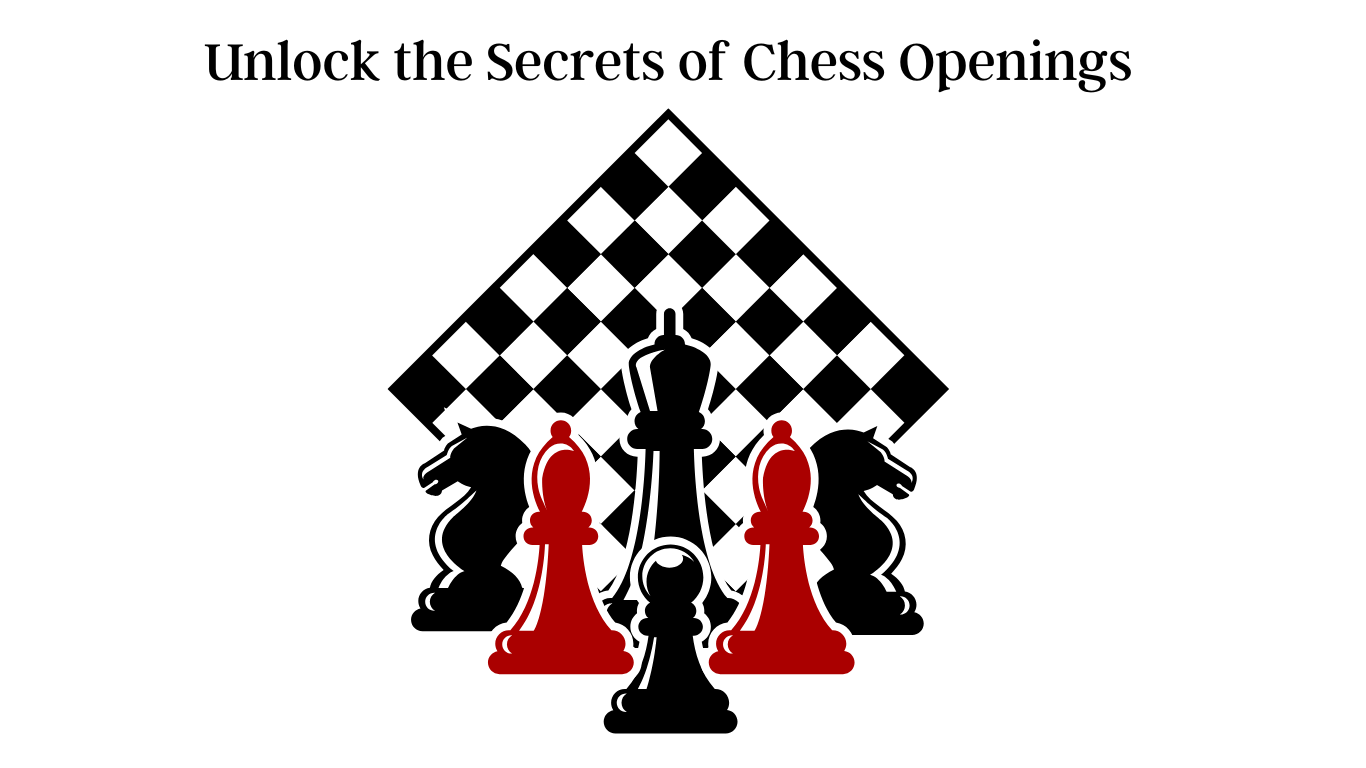Secrets of Chess Openings
“Unlock the Secrets of Chess Openings” is a phrase commonly used to refer to the study and exploration of the initial moves in a game of chess.
Chess openings are critical because they set the stage for the rest of the game, influencing both players’ strategies and determining the potential strengths and weaknesses of their positions.
This phrase encapsulates the idea that there are countless variations and possibilities within chess openings, and that understanding and mastering them can greatly improve one’s overall game. By studying the most common and effective opening moves and tactics, players can gain a deeper understanding of the game’s mechanics and develop a strategic edge over their opponents.
To unlock the secrets of chess openings, players must devote time and effort to studying and analyzing various opening strategies and moves. This can involve reviewing annotated games, studying openings books and videos, or practising with other players to gain a better understanding of the various nuances and subtleties involved in the opening play.
“Unlock the Secrets of Chess Openings” emphasizes the importance of understanding and mastering the initial moves of the game, which can ultimately lead to greater success and enjoyment in playing chess.
The Unlock the Secrets of chess opening is one of the most important phases of the game. You need to develop your pieces and position them correctly before your opponent does. This is why it is crucial to memorize a few chess openings. However, don’t become too reliant on memorization as it can lead to errors.
1. Caro-Kann
The Caro-Kann is a solid defence that allows Black to develop his pieces and reach a playable endgame without worrying about weaknesses. Moreover, the Caro-Kann has a great deal of versatility and caters to all playing styles.
It is not uncommon for this opening to be the preferred choice of world chess champions such as Magnus Carlsen and Levon Aronian. However, this opening can be complicated and is not suitable for all players.
In this book, GM Nigel Davies examines the main lines of the Caro-Kann defence and shows how this opening can be used to unlock the secrets of chess openings. He covers a number of important positions from both sides, including some critical lines with doubled f-pawns that can prove very dangerous in the modern game.
Many of the modern Caro-Kann main lines involve moves that look extravagant, but they are backed up by a deep underlying logic. These lines can lead to sharp positions, with chances for both sides.
White often seeks to castle queenside to gain time while expanding on the kingside. This is a strategic move, as it can be followed by the timely c6-c5 attack, which contests the d4 square and weakens Black’s position.
The Advance Variation, in which White puts his pawn on d5 before Black develops his bishop, is another strong line. Unlike the classic variation, this attack is not vulnerable to a b3-b4 development. It also prevents Black from capturing on f4, as this attack requires a c4-pawn.
The Tartakower Variation is another popular line of the Caro-Kann. This line is a favourite of former world chess champions such as Vasily Smylov. It also offers a great advantage for White in the middle game.
2. Queen’s Pawn Opening
The Queen’s Pawn Opening is one of white’s most popular chess opening options. It allows white to control the centre and open lines for the development of his pieces, but black has a number of defences to this opening.
In this opening, black tries to block out white’s pawns and develop his own kingside bishop. This opens up the centre of the board, but black must take care not to let her pawns get into white’s territory or else she could lose the game quickly.
Most of the black’s most popular set-ups begin by playing 1…Nf6. This move is logical because it prevents white from playing an immediate 2.e4 and seizing the centre.
As with all chess openings, there are a number of different responses to this setup. These are divided into two categories: The Queen’s Gambit Accepted (QGA) and the Queen’s Gambit Declined (QGD).
For the QGA, white offers a pawn in exchange for a powerful centre and a chance to open his Queen’s Bishop. This is the most popular pawn sacrifice in all of chess opening theory, and it can be a huge advantage for white.
The QGD is a more complex option, and it offers black several strong options. She can castle on the kingside and threaten white’s dark-squared bishop, she can withdraw her knight to f6 and castle there, or can try to keep the c4 pawn strong with a later e3 attack.
This is a good way to unlock the secrets of chess openings, and it can help you win a lot of games in the future! If you want to become a chess master, make sure you know these opening secrets before you play your next game.
3. Queen’s Gambit
The Queen’s Gambit has been a staple of chess for centuries, with players from all walks of life utilizing it to unlock the secrets of their openings. This book teaches you the fundamentals of White’s repertoire in this illustrious opening, and shows you how to use it to your advantage to make sure you never lose a game again!
The openings are the first part of a chess game, and they determine how successful your opponent will be. The better you are at these openings, the easier it will be for you to win the rest of the game.
Unlike other openings, the Queen’s Gambit has a long and distinguished history, with virtually all the strongest grandmasters in the world have played it at some point. However, it can still be an intimidating opening for beginners to play, as it requires a lot of skill and knowledge.

In this opening, White moves the c-pawn to d4 and then brings the queen back into the centre. This creates a strong position for White, and Black is forced to play his knight, which prevents White from developing his queen.
There are several ways for Black to respond to the Queen’s Gambit, including the Queen’s Gambit Accepted (QGA), the Queen’s Gambit Declined (QGD), and the Ragozin Variation.
The QGA is the most popular response, and it usually involves playing 2…dxc4, temporarily giving up the centre to obtain free development.
The Queen’s Gambit has a reputation as being difficult to defend, which is why reigning world chess champion Magnus Carlsen has made it his preferred opening. However, the risk of this move is too high for most players to take, so this opening should be avoided if possible.
4. Queen’s Indian
The Queen’s Indian is a solid response to 1.d4 and offers an excellent platform for improving your general positional feeling. Instead of trying to memorize long and forced variations, you can focus on gaining a deeper understanding of the opening and start to play it from a more holistic perspective.
During this workshop, GM Grigor Grigorov will show you how to unlock the secrets of this opening. He will explain all the must-know positional and tactical ideas, helping you to improve your overall understanding of the classical openings.
One of the best and most popular openings against 1.d4 is the Queen’s Indian, which is a dynamic chess opening that can lead to rich and complicated games. This opening is based on the principle of controlling the centre with pieces rather than pawns, which can create many complex positions.
This line is a favourite of both White and Black but can be challenging to master. This book will help you to understand the basic moves and aims of the Queen’s Indian and is a must-have for any chess player who wants to increase their level of play.
Another great book to get you started with the Queen’s Indian is IM Andrew Greet’s Queen’s Indian repertoire for Black. This book will teach you all the important variations for Black in the Queen’s Indian and also provide you with some essential hints on how to counter all of White’s tries for an advantage.
The Queen’s Indian is an exciting and versatile chess opening that has been used by world-class players to gain control over the centre of the game. It is a difficult opening to master, but once you have mastered it, you will have an excellent foundation for improving your play.
5. The Hippo Opening
The Hippo Opening (also known as the Hippopotamus Defense) is a chess opening that can be used by both sides in the early stages of a game. It is a popular opening choice for players at all levels and can be used against virtually all of White’s choices including 1.e4, 1.d4, 1.c4, 1.f4, the Colle, London, Trompowsky, Reti and many others.
It is also a good choice against a number of closed openings, including the English, King’s Indian and Sicilian systems. The Hippo is a good opening for players who are looking for something a little different and will surprise a lot of their opponents.
In order to understand The Hippo Opening, it is important to have a basic understanding of the basic moves and key variations. Once you have this knowledge you will be able to use it to unlock the secrets of chess openings and develop your own specialized strategies.
A chess opening is a sequence of moves that are based on established theory. When a chess player deviates from these moves, they are said to be “out of the book”.
Most openings have names that are associated with geographical places and people who advocated them. These are known as “named openings”. During the 18th century, chess players began to classify and study openings. However, this process was haphazard and opening nomenclature has not been standardized.
Rather, the names are based on historical accidents and do not represent any systematic principles. The most common types of named openings are:


